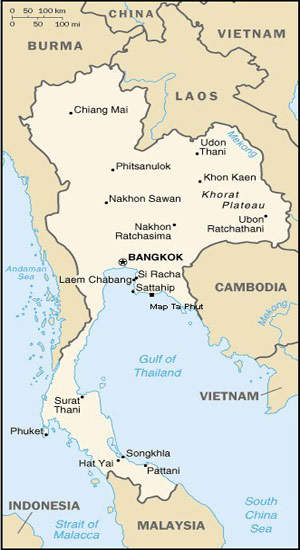
The world price of energy is increasing constantly and Map Ta Phut (220km southeast of Bangkok) is an example of an LNG regasification facility being built by a country hedging its bets (not wanting to be left behind in the rush for natural gas).
The project is being developed by PTT LNG Company Ltd (PTTLNG), a subsidiary of PTT Thai National Petro Chemical Company. The demand for liquid natural gas and, in turn, for new LNG ports is rising rapidly. In addition the facility is being constructed near to the Map Ta Phut industrial complex where a number of industries are setting up plants that may require natural gas feedstock.
Industries here include petrochemical, refinery, steel, fertiliser plant and plants under construction by GS E&C include Aromatics No.2 (aromatics plant) and HMC PP (Line-3) (polypropylene).
PTT LNG PROJECT
In February 2008 PTT plc was in talks with the Egco Group and the Electricity Generating Authority of Thailand (Egat) to form a new consortium to run the new $930m LNG project. This follows an agreement made previously in 2006. PTTLNG will expect to retain around a 45% share of the project.
The new facility will involve the development of a deepwater port, a five-million-ton regasification (vaporiser) train with two 160,000m³ LNG storage tanks, a jetty, a boil-off gas recondensor, a send-out station and an LNG pump. The terminal is scheduled to start operating in 2011 (construction completed by June 2011).
Phase two of the project, which is already being considered, will add a further LNG tank of 160,000m³ and also a further jetty (7.5 million tons capacity). The phase three proposals could involve a further jetty and another LNG tank of 160,000m³ (ten million tons capacity).
GAS CONTRACTS
PTTLNG failed to come to agreement for a supply contract from the Iranian Pars field for three million tons of LNG a year for 20 years and this has delayed the regasification terminal project to some extent.
However in February 2008 PTT signed an agreement with Qatargas Operating Co. in Doha to purchase one million tons of LNG a year with delivery to start in early 2011 over a ten-year period (there is also an option for a further one million tons if required).
Negotiations are also underway with LNG suppliers in Indonesia, Australia and the Middle East to fill the full five-million-tons-a-year capacity of the new facility.
Natural gas actually already accounts for two-thirds of the fuel used to generate Thailand’s electricity, and the development of new sources has been deemed critical for the establishment of long-term energy security.
DREDGING
In December 2007 Van Oord was awarded a contract worth €53m for dredging work in Map Ta Phut on the east coast of Thailand.
The project started in January 2008 and is scheduled to be completed in April 2009.
The dredging project involves broadening and extending the port entrance to take the new large gas tankers (around five million cubic metres of dredging work), removing silt layers, and also reclaiming land for the LNG terminal development. There will also be a need for the construction of an access route and dykes. Van Oord has deployed a cutter suction dredger on the project.
OTHER CONTRACTORS
Construction has already started in 2008 and although not all of the contracts have gone out to tender yet there are some major engineering companies involved in the project. These include the project managing Korean E&C consortium consisting of GS E&C (Engineering and Construction – putting up $390m finance towards the project), Korea Gas Corp, Hanyang Corp and Daewoo Eng.



